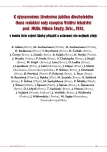Heart transplantation
Authors:
P. Hude 1; L. Špinarová 1; J. Krejčí 1; H. Bedáňová 2; P. Němec 2; J. Vítovec 1
Authors‘ workplace:
I. interní kardio-angiologická klinika Lékařské fakulty MU a FN u sv. Anny Brno, přednosta prof. MUDr. Jiří Vítovec, CSc., FESC
1; Centrum kardiovaskulární a transplantační chirurgie Brno, ředitel doc. MUDr. Petr Němec, CSc.
2
Published in:
Vnitř Lék 2009; 55(9): 711-717
Category:
80th Birthday - prof. MUDr. Miloš Štejfa, DrSc., FESC
Overview
The first heart transplantation (SHT) was performed by Professor Ch. Barnard in 1967 but it was not until 1980s that this method became an established approach to treatment of patients with end-stage heart failure. Considering the limited number of donor organs and the number of potential post-transplantation complications, the decision to perform heart transplantation at the right time in an indicated patient is difficult and complex. Subsequent pharmacological management with immunosuppressive agents and other medication becomes everyday life reality. Knowledge of drug interactions and collaboration with cardiologists are necessary in order to maintain long-term treatment success. Despite the current developments in surgical methods, examination methods and immunosuppressant therapy, a range of complications has to be dealt with. The future of care for patients with transplants will rely on the development of new immunosuppressive drugs with a minimum of adverse effects and discovery of a non-invasive technique for graft rejection diagnosis.
Key words:
heart failure – transplantation – indication – immunosuppressive therapy
Sources
1. Černý J. Historie srdečních transplantací – krátké zamyšlení. Vnitř Lék 2000; 46 : 741–742.
2. Fabián J, Gonçalvesová E, Štefanková I. Zlyhávanie a transplatácia srdca. Bratislava: Herba 2007.
3. Hegarová M, Málek I. Imunosupresiva po transplantaci srdce. Kardioforum 2005; 3 : 16–21.
4. Hošková L, Málek I, Šedivý J et al. Lékové interakce cyklosporinu A. Cor Vasa 2002; 44 : 481–488.
5. Hude P, Horký M, Krejčí J et al. Apoptosis plays role in cellular rejection after human heart transplantation. Eur J Heart Fail 2004; 3 (Suppl 9).
6. Hunt J, Lerman M, Dewey T et al. Conversion to sirolimus lessens renal dysfunction in heart transplant patients. J Heart Lung Transpl 2004; 23 (Suppl 2): 113.
7. Kobashigawa JA, Katznelson S, Laks H et al. Effect of pravastatin on outcomes after cardiac transplantation. N Engl J Med 1995; 333 : 621–627.
8. Kocík M, Dufková B, Málek I. Koronární nemoc srdečního štěpu. Kardioforum 2005; 3 : 25–28.
9. Kočandrle V, Fabián J, Firt P. Transplantace srdce. Čas Lék Čes 1984; 123 : 1425–1429.
10. Kousalová L, Baranová J, Anzenbacher P. Lékové interakce na úrovni cytochromů P450–CYP3A4. Klin Farmakol Farm 2003; 17 : 151–157.
11. Krejčí J, Hude P, Špinarová L et al. Transplantace srdce – indikace, komplikace, terapie – naše zkušenosti ze sledování 100 pacientů po srdeční transplantaci. Vnitř Lék 2000; 46 : 750–755.
12. Lácha J. Úskalí imunosupresivní léčby. Vnitř Lék 2003; 49 : 430–433.
13. Málek I. Indikace k transplantaci srdce. Cor Vasa 2008; 50 : 129–132.
14. Málek I. Péče o nemocné po transplantaci srdce. Interv Akut Kardiol 2006; 5 : 116–121.
15. Mancini D, Pinney S, Burkhoff D et al. Use of rapamycin slows progression of cardiac transplantation vasculopathy. Circulation 2003; 108 : 48–53.
16. Martínek V, Matoušovic K, Špatenka J. Objev a užití cyklosporinu v klinické praxi. Prakt Lék 2002; 82 : 14–20.
17. Michaels PJ, Espejo ML, Kobashigawa Jet al. Humoral rejection in cardiac transplantation: risk factors, hemodynamic consequences and relationship to transplant coronary artery disease. J Heart Lung Transplant 2003; 22 : 58–69.
18. Rinaldi M, Pellegrini C, Martinelli L et al. FK506 effectiveness in reducing rejection after heart transplantation: a prospective randomised study. J Heart Lung Transplant 1997; 16 : 1001–1010.
19. Špinarová L, Hude P, Krejčí J et al. Vývoj imunosupresivních režimů v průběhu 10 let u pacientů po transplantaci srdce. Sborník abstrakt 6. kongresu České transplantační společnosti, Praha, 14.–16. 10. 2004.
20. Špinarová L, Toman J. Fluvastatin u pacientů po transplantaci srdce. Vnitř Lék 1998; 44 : 13–16.
21. Špinarová L, Toman J. Pharmacotherapy after heart transplantation. Cor Vasa 2000; 42 : 335–340.
22. Špinarová L, Hude P, Krejčí J et al. Osud pacientů přežívajících deset let po transplantaci srdce se zřetelem k výskytu maligního onemocnění. Cor Vasa 2009; 51 : 415–418.
23. Viklický O, Matl I. Rapamycin: nové imunosupresivum schopné potlačit chronickou rejekci? Čas Lék Čes 2001; 140 : 22–25.
24. Vítovec J, Špinar J. Farmakoterapie kardiovaskulárních onemocnění. Praha: Grada Publishing 2004.
25. Vítovec J, Špinarová L. Jaký statin po srdeční transplantaci? Farmakologická teorie a klinická praxe. Cor Vasa 2004; 46 : 463–464.
26. Vymětalová Y, Málek I. Akutní rejekce po transplantaci srdce. Kardioforum 2005; 3 : 12–15.
Labels
Diabetology Endocrinology Internal medicineArticle was published in
Internal Medicine

2009 Issue 9
Most read in this issue
- Cholesterol levels according to age
- B-cell chronic lymphocytic leukaemia and the similar states
- Liver cirrhosis and its treatment
- Transplantation of haematopoietic cells
